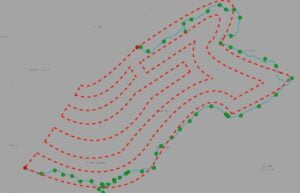ENF Director, Svend McEwan-Brown explains why the festival has a labyrinth this year…
I have been hooked on labyrinths for a very long time. I know the word has some unhappy resonances: the Minotaur’s labyrinth (not a happy place), labyrinthine plots (confusing and annoying), labyrinthitis (very nasty), but to me, labyrinths are special places for thinking, playing, and relaxing.
The history of labyrinths is long (read an excellent short overview HERE), and they clearly fill a profound need in humans. They are easy to confuse with (equally ancient) mazes but in fact they are the opposite: a maze is a puzzle to be solved, while a labyrinth is not there to confound you. You can usually see the whole thing, and the path generally only goes one way; the act of walking it has, since ancient times, been an aid to prayer or thought. And for me – Because my brain is made this way – labyrinths are very musical. Listening to a long-ish piece of music is so often like walking a path, encountering melodies and other musical ideas from different perspectives as you move along it. At bottom, that’s why we have a labyrinth at ENF this year. Of course there is another, very current reason, which is that in this time of Covid I’ve been considering all kinds of possibilities for events and happenings that we can deliver safely to enough people for it to make sense to do them. So having something like this which can be in place for months and bring pleasure to many is a wonderful thing.
I’ve had the pleasure of commissioning two labyrinths before, both linked to music and to play. A few years ago in Glasgow, the veteran labyrinth creator Jim Buchanan created a water labyrinth in Glasgow City Halls. Projected patterns on a pool of water delighted all ages from toddlers to the elderly, and played a part in family days and arcane electronica performances equally successfully. Then, in Fife, Hilke McIntyre created a labyrinth which was also a schematic map of the East Neuk.

Laid out in Crail Community Hall, it was around the size of a badminton court and as well as being a beautiful graphic, it encapsulated many aspects of the area, its landscape, history, industries, and towns. Again, its invitation was to walk and enjoy the artwork quietly and peacefully, or to play. Children ran around it; others paced reflectively.
This year’s labyrinth is the first that I have designed myself. Like Hilke, I took inspiration from the East Neuk itself and my starting point was the coastline (also the route of Fife Coastal Path), which famously resembles a Scottie dog’s head. I took that pattern and mapped it out and then drew the rest of the labyrinth from there.

My pattern was taken by Chris Randall, who used GPRS technology to map it onto the wildflower meadow at Kellie Castle. Then he and ENF producer Danni Bastian marked it all up, and the NTS team of gardeners made a cut into the meadow following the pattern.

Aerial photo of the Labyrinth at Kellie Castle by Katie Chalmers
It has some growing to do before it looks its best, but as they continue to mow the pattern from now till July my hope is that, seen from above, the pattern will be increasingly beautiful and from the ground it will provide a very special way of enjoying that lovely space this year. Who knows, we may even be able to have some music there… Even now, I guess you could (virtually) walk the Fife Coastal Path by following one edge of it – and it would only take you about a minute.




